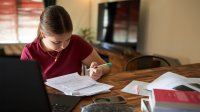How to Help Students Develop the Skills They Need to Complete Homework
Middle and high school students can learn to work more efficiently by using strategies that improve their executive function skills.
Your content has been saved!
Go to My Saved Content.The effects of homework are mixed. While adolescents across middle and high school have an array of life situations that can make doing homework easier or harder, it’s well known that homework magnifies inequity. However, we also know that learning how to manage time and work independently outside of the school day is valuable for lifelong learning. From the homework wars to students who have little time for homework to students who don’t even know where to begin, everyone can agree that kids who can self-regulate and engage in independent rehearsal are better positioned for whatever the future holds.
How can we empower students to overcome barriers to doing homework well?
Executive Functioning
Homework is partially an assessment of executive functioning. Executive functioning and self-regulation take time to develop. They depend on three types of critical brain function: working memory, mental flexibility, and self-regulation.
Let’s break this down to consider how to improve their efficiency.
Working memory: Don’t hold everything in your head; it is not possible. When doing homework, students should write down their ideas, whether they are notes while reading, numbers when working through a math problem, or non-school-related reminders about chores, such as remembering to take the dog for a walk. Clearing working memory for the immediate task at hand allows the brain to focus as the strain is reduced.
Mental flexibility: As students build their independence and grow their homework routines, seeing an array of strategies, or more than one way to solve a problem, is important. Consider the results when a child gets stuck and doesn’t know what to do to get unstuck or when one keeps trying the same failed approach. Chunking homework helps simplify the process. When stuck, a student looks at a smaller piece, which makes it easier to see other solutions. More practice with mental flexibility happens when others model thinking in different ways, and students practice flexible thinking with partners by asking them: What is another way? Use this bubble map to chart out multiple ways.
Self-regulation: Learning how to prioritize work and stick with it by not giving in to impulses is a skill that students develop over time. One way to teach self-regulation is to have students practice control by concentrating for short periods of time with the goal of building up to longer, more sustained periods of time as the year progresses. For a child who struggles with reading for an extended time, start with five minutes and then build from there.
Another self-regulation tip is creating a plan to overcome distractions. What happens when the child stumbles? Three minutes into reading and a student is reaching for their cell phone. Recommend that they practice moving the cell phone away from the homework area, and summarize before returning to the reading. Stops and starts are frustrating and often result in lost homework time. Have students practice responses to distraction, and make this part of their homework. When a student struggles to stay on task, they should be encouraged to remove any distraction in order to regain focus.
Assessment
Use classroom assessment as a tool to plan for and support student homework. Record the following information for students:
- Do they write, read, and/or solve problems in class? For how many minutes independently?
- What is the quality of their work? Are they actually learning, or are they just going through the motions?
- Do they know how to strategize on their own or get help from a peer when they’re stuck? Observe them and take notes, and/or have them reflect on this question.
We cannot expect that students will independently practice a skill they don’t engage with during class. If it doesn't happen in the classroom, it's not going to happen at home. The teacher should be able to realistically gauge how much and what students might achieve at home. A suggestion to build independence is to use task analysis. Here is a model. For students who struggle with getting homework done, at first they may not actually do homework; rather, they practice the routines of setting up and getting started.
Direct Instruction
The following are some techniques that help students with homework:
Peers as Partners
Class partnership routines need practice. With strong partnerships, kids learn how to support and learn from each other. Access to teachers will never match the unlimited access to peers. The hours that students who achieve at high levels put in after class are often spent alone rehearsing the content or with peers who push each other to improve.
Class-to-Home Connection
While some students struggle with executive functioning, others rush through their homework. The most important step in having homework count is to make it seamless, not separate from class. Homework flows from classwork. Especially with a mix of synchronous and asynchronous work, now there is no homework, just work done for our classes. Consistent instructional goals with engaging and meaningful tasks help students see the value in working beyond the last bell.
